Filed under: Flora, Observations | Tags: Flora, Livingstone National Park, Nature, Orchids, Photography, Wagga, Wagga Wagga, Wildflowers
Bulbine Lily (Bulbine bulbosa)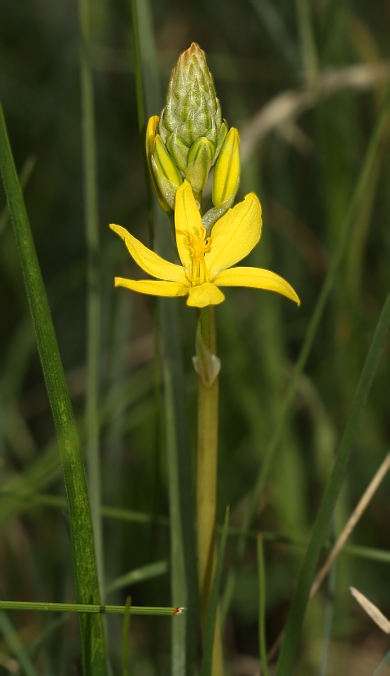
The first of Willans Hill’s bulbine lilies emerged just over a week ago. Bulbines are extremely common and conspicuous, making them a good indicator of the onset of spring. A few less noticeable species have also begun flowering on the hill, including the glycines (Glycine spp.) and the native geranium (Geranium solanderi).
Livingstone National Park is home to the greatest diversity of plant life in the region, and a number of interesting species have started to emerge there. The parrot’s beak orchid (Pterostylis nutans), also known as the nodding greenhood, is one example.
Parrot's Beak Orchid (Pterostylis nutans)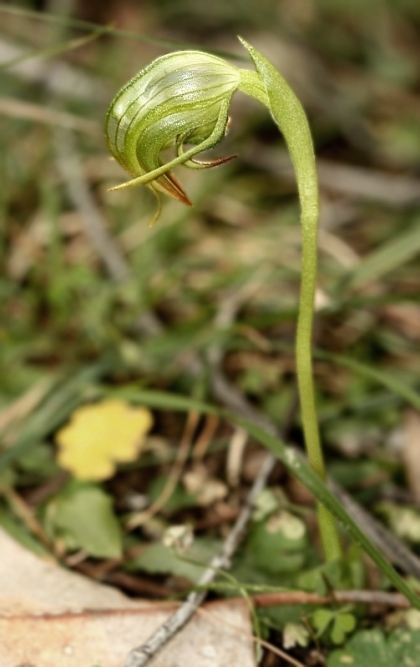
Among the more interesting plants recorded in flower at Livingstone were the peach heath (Lissanthe strigosa), the pea-flower Hovea heterophylla, the granite mintbush (Prostanthera granitica) and a species of sundew (Drosera sp.), a carnivorous plant.
Peach Heath (Lissanthe strigosa)
Granite Mintbush (Prostanthera granitica)
Also recorded were a species of buttercup (Ranunculus sp.), the purple coral-pea (Hardenbergia violacea) and a tiny star (Hypoxis sp.). The austral bear’s ear (Cymbonotus preissianus), an inconspicuous and unspectacular plant, was also in flower.
The golden wattle (Acacia pycnantha) is flowering along roadsides near Livingstone, as is the early wattle (Acacia genistifolia) and another species that may be the gold-dust wattle (Acacia acinacea). Within the park itself, some kangaroo thorn (Acacia paradoxa) and ploughshare wattle (Acacia gunnii) plants carried a few flowers.
Also recorded recently in Livingstone was a species of mosquito orchid (possiblyAcianthus collinus ).
Mosquito Orchid (Acianthus sp.)
Acianthus collinus is winter-flowering, rather than spring-flowering. This is the fourteenth orchid species I have recorded at Livingstone.
—
Addendum (13/08): Some Creamy Candles (Stackhousia monogyna) have started to emerge as well.
Creamy Candles (Stackhousia monogyna)
Also, a patch of greenhoods (possibly Pterostylis nana) was recorded on Willans Hill.
Filed under: Fungi, Observations | Tags: Fungi, Livingstone National Park, Nature, Photography, Wagga, Wagga Wagga
A sequel to this earlier post.
A. M. Young (A Field Guide to the Fungi of Australia, UNSW Press) estimates that there may be as many as 250 000 species of fungus in Australia, of which the vast majority are the so-called ‘microfungi’ – moulds, plant rusts, mildews and so on. ‘Macrofungi’ (mushrooms, toadstools, puffballs, cups, jellies, coral fungi and so on) account for a relatively small percentage of our overall fungal flora, but there may still be as many as 20 000 macrofungus species in Australia. Most of these are undescribed; many are entirely unknown.
Little is known about the distribution of Australian fungus species (except that the rainforests of eastern Queensland and New South Wales are probably among the most diverse locations), so there is no estimate for the number of species found in the Wagga Wagga area. The thumbnail gallery presently contains 57 images, accounting for probably 54 species (though many have not been properly identified). There are likely to be several hundred more occurring in the area.
This post illustrates a few of the more interesting fungus species from the area.
—
Mycena clarkeana seems to vary from a vivid pink to a darkish pink-brown. This identification (which is by no means certain) was suggested by I. R. McCann’s Australian Fungi Illustrated.
This photograph was taken in a well-treed area along the Mundarlo Road, which seems to support a surprising diversity (as roadsides go) of both flora and fauna. The fungus was found growing in a sheltered spot at the base of a eucalypt.
—
This species produces tiny parasols on the side of (in fact, almost underneath) rotting logs. This behaviour is shared by many members of the genus Mycena, making identification extremely difficult.
This photograph was taken at Wiesners Swamp Nature Reserve, which is roughly 100km (so Google Maps tells me) south-west of Wagga Wagga. Specimens belonging to this species, or to a closely related species, are often found much closer to Wagga, however.
—
Rooting Shank (Xerula or Oudmansiella radicata)
This is a common and distinctive species, identified by its tall stem (which extends a short distance underground), its brown cap and its bright white gills. The subterranean part of the stem resembles a long taproot, giving the species its common name. The Rooting Shank can be quite viscid when wet but seems to dry rapidly in warmer weather. Young specimens have rounded caps, whereas older ones tend to have flattened caps, sometimes with a small raised section in the middle (called the ‘boss’ or ‘umbo’).
This species has been recorded along Mundarlo Road, on Willans Hill (where the photograph was taken) and at Livingstone National Park. It is likely to be found elsewhere.
—
Ramaria species produce coral- or lichen-like fruiting bodies, often amongst leaf-litter in woodland. The photograph above shows the only coral fungus specimen I have seen in the Wagga area. It is assumed to be a species of Ramaria, though there are at least two other genera of coral fungus represented in Australia (Ramariopsis and Clavaria). This specimen was found on the northern part of Livingstone National Park.
—
Small Dung-buttons (Poronia erici)
Poronia erici is a common and distinctive coprophilous (dung-loving) species. It is usually found on kangaroo dung, but according to Bruce Fuhrer (A Field Guide to Australian Fungi, Bloomings Books) it can also occur on wombat, rabbit and occasionally horse dung. Individual discs (or ‘buttons’) are less (often much less) than 1cm in diameter.
It has been recorded at Mates Gully Rd. TSR, Wokolena Rd. TSR, Willans Hill and Livingstone National Park, and can probably be found wherever there are kangaroos (which is almost anywhere, really). The photograph above was taken at Mates Gully.
—
Bird's Nest Fungus (Crucibulum laeve)
The earlier post on fungi profiled the coprophilous Bird’s Nest fungus Cyathus stercoreus, which has been recorded at Mates Gully Rd. TSR and Kyeamba TSR. The species above grows on wood rather than dung and has been recorded at Matong, Ganmain and Kindra State Forests. Crucibulum laeve produces smaller fruiting bodies than its dung-loving cousin and is pale brown rather than blackish in colour. It grows in large clusters – the photograph shows only a small part of a much larger colony, possibly consisting of several hundred fruiting bodies.
This photograph was taken in Kindra State Forest near Coolamon.
—
This identification is somewhat tentative. I have based it on the manner in which the outer skin (which is rubbery and rather clammy in young fruits) dries and cracks to reveal the spore mass, a habit it shares with, for example, Calvatia cyathiformis. (See the wonderful Australian Fungi – a blog for information on that species).
This is quite a large species – the specimen photographed reached almost 20cm in diameter – but next to its relative Calvatia gigantea, which has been known to reach 150cm, it seems rather pathetic. That species is not found in Australia.
The photograph was taken in January of this year. The specimen was found in a lawn composed principally of introduced grasses (with some Wallaby Grass Austrodanthonia sp.) on the edge of Willans Hill.
—
Lawyer's Wigs (Coprinus comatus) - Young
Coprinus comatus is a common species of lawns and parks around Wagga. It often grows in loose colonies, as here. It is also known as the Shaggy Ink Cap.
Lawyer's Wig (Coprinus comatus) - Young
Once these fruiting bodies reach maturity they quickly begin to autodigest, and before long all that will be left is a thick black liquid and a stem.
This photograph was taken on Pine Gully Rd., near Joyes Hall. Nearby was a colony of the Yellow Stainer (Agaricus xanthodermus) and a number of unidentified puffballs.
This is only a small selection of local species. For more, see the thumbnail gallery.
Filed under: Flora | Tags: Flora, Livingstone National Park, Nature, Orchids, Photography, Wagga, Wagga Wagga, Wildflowers
Livingstone National Park has been logged, mined for gold, tin and wolframite, and used as a bombing range. And yet it is almost certainly the best-preserved area of remnant vegetation in the vicinity of Wagga. It was finally gazetted (as Livingstone National Park and Nature Reserve) in 2001. In 2006, the southern end (adjacent to the locality of Burrandana) was declared a State Conservation Area.
The park is apparently home to 20 or more species of orchid. Nine spring-flowering species were documented in this earlier post. PlantNET lists four further spring-flowering species (Caladenia dimorpha, C. phaeoclavia, Pterostylis mutica and Thelymitra ixioides) in the park. The management plan lists another four species: the greenhoods Pterostylis curta and Pterostylis longifolia, the ruddyhood Pterostylis pusilla and the tiny finger orchid Caladenia mentiens. Additionally, four species of autumn-flowering orchid are known from the park. These are profiled here.
* * *
Parson's Bands (Eriochilus cucullatus)
Eriochilus cucullatus is a tiny, delicate and inconspicuous species. Each plant may carry up to five flowers, though most have only one or two. It has been recorded from the both the northern and southern sections of the park, and also from Murraguldrie Flora Reserve.
Rufous Midge Orchid (Genoplesium rufum)
This identification is tentative. Genoplesium is a large genus, but G. rufum is the only species listed by PlantNET for the NSW South-West Slopes bioregion. This species is extremely variable. Its colouration runs the gamut from deep purple-black to mostly green with reddish or brownish tips to the lateral sepals (as in this case). Some debate exists as to whether Genoplesium rufum constitutes a single species or a complex of related varieties. The flowers on this particular specimen have closed for the year.
Tiny Greenhood (Pterostylis sp. aff. parviflora)
The Pterostylis sp. aff. parviflora complex accounts for almost a dozen species, subspecies or varieties of orchid. The variety found at Livingstone (assuming there is only one) may be the one referred to in Bishop’s 1996 field guide (currently out of print) as Pterostylis sp. aff. parviflora (Large Red-brown). Complicating this identification is the fact that many plants were found to have seven or eight flowers, whereas Bishop claims that Pterostylis sp. aff. parviflora (Large Red-brown) only rarely has more than six. Another variety it resembles commonly has up to eight flowers, but is known only from the Melbourne, Victoria area (designated by Bishop as Pterostylis sp. aff. parviflora (Eastern Melbourne)).
Tthe genus Speculantha has been proposed to distinguish the tiny greenhoods from the larger species, like the one below.
Sickle Greenhood (Pterostylis falcata)
Another complicated identification. Pterostylis falcata is not recognised by Bishop and does not have an entry in PlantNET’s Flora of New South Wales. Nevertheless it is the only autumn-flowering greenhood that comes up in a PlantNET search for the flora of the Wagga Wagga LGA. (That list is not complete, however)
This species is extremely common in Livingstone National Park, often occuring in colonies of up to thirty plants. These colonies are composed of plants at varying stages of maturity. Younger and older flowers often take on unusual shapes:
Sickle Greenhood (Pterostylis falcata)
* * *
Coming soon: posts on Nest Hill Nature Reserve and Plum Pudding Hill TSR and a series of posts on common urban and suburban birds of Wagga.
Filed under: Fungi | Tags: Fungi, Livingstone National Park, Nature, Photography, Wagga, Wagga Wagga
This post has been a long time in coming. Apologies!
—
The rains in December, February and March brought out a large crop of fungi of various kinds, and now, with the temperature dropping and dew beginning to form, there seems to be a constant supply of unusual and interesting fungus species. A few of the more interesting are shown below.
Resupinatus cinerascens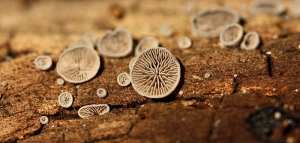
Resupinatus cinerascens is a tiny fungus – the largest fruiting body being around 1cm in diameter – found on the underside of rotting logs. This particular specimen was found in Wallacetown.
***
Fairy's Parasol (Coprinus plicatilis) Fairy's Parasols (Coprinus plicatilis)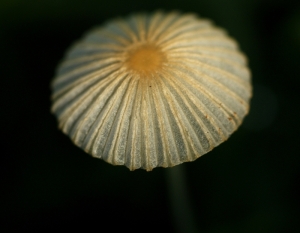
Coprinus plicatilis is a common but inconspicuous fungus of lawns and gardens. The fruit has an extremely short life, sometimes lasting only a few hours before putrefaction sets in. It occurs in clusters as seen here:
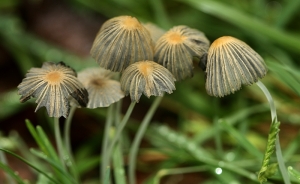
Young fruits are only a few millimetres across.
***
Jelly Fungus (Calocera sp.)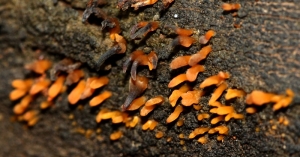
The genus Calocera contains a number of very similar ‘jelly’ fungi. This specimen was photographed on the side of a rotting log in Ganmain State Forest.
***
Earth Star (Geastrum triplex)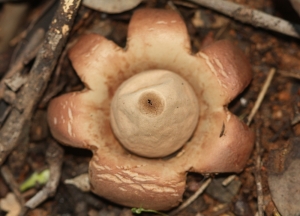
Geastrum triplex is larger and more attractive than most of the Earth Stars found in the area. It seems to occur in colonies in very wet leaf litter.
Earth Star (Geastrum triplex) group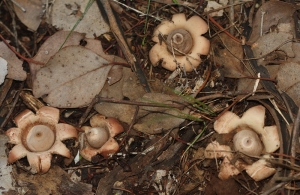
This particular colony was found in a wet gully on the northern end of Livingstone National Park.
***
Phylloporus clelandii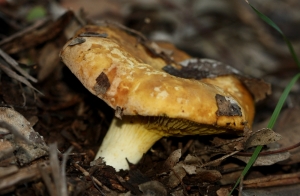
This fungus has been tentatively identified as Phylloporus clelandii, one of a group of large, fleshy fungi sometimes referred to as gilled boletes (true boletes have pores rather than gills on the undersurface of the cap). This fungus is, according to Bruce Fuhrer’s field guide, generally uncommon. This particular specimen was again photographed on the northern end of Livingstone National Park.
***
Macrolepiota sp. Macrolepiota sp.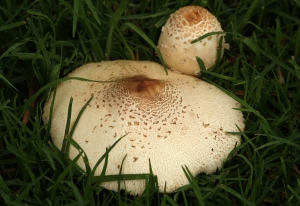
Macrolepiota species are very large (around 20cm, in this case) and are found in a variety of locations. The specimens seen here were part of a very large colony found in the grounds of the Wagga Wagga Botanic Gardens. Despite their size the young fruiting bodies grew very close together:
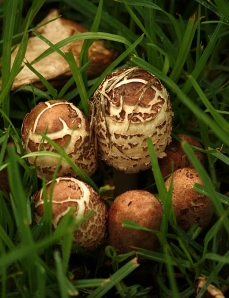
Competition for space may explain why many of the fruiting bodies had been uprooted. This particular species – found as it was in a lawn composed of exotic grasses – may not be native to Australia.
***
Bird's-Nest Fungus (Cyathus stercoreus)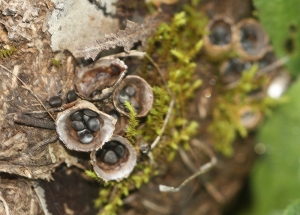
Finally, the bird’s-nest fungus Cyathus stercoreus. This extraordinary species is usually found on herbivore dung – in this case cow. The small ‘seeds’ or ‘eggs’ are called peridioles. These contain the spores and are dispersed by raindrops. This cluster of fruiting bodies was spotted at the Kyeamba TSR (which may recieve a full profile at a later date).
—
I hope soon to add a post on the autumn-flowering orchids recorded in the area. The bird count remains unchanged.
Filed under: Flora, General, Lists | Tags: Flora, Livingstone National Park, Nature, Photography, Reptiles, Wagga, Wildflowers
This post profiles a selection of the more interesting flora and fauna recorded in and around Livingstone National Park. A birdlist for the area is available here. See also this earlier post on the park’s orchids.
Common Fringe-myrtle (Calytrix tetragona)
Nodding Blue Lily (Stypandra glauca)
Stypandra glauca is probably the most common – certainly the most conspicuous – of the park’s groundcover species. It has a dense, shrubby growth habit.
Murnong or Yam Daisy (Microseris lanceolata)
Bulbine Lily (Bulbine bulbosa)
In the early part of the 20th century, when native species weren’t sacrosanct, the Bulbine Lily was considered a serious weed. It has an enduring reputation for causing diarrhoea in stock.
Finger Flower (Cheiranthera linearis)
The Finger Flower gets its name from the five yellow anthers that resemble (if only slightly) outstretched fingers.
Wattle Mat-Rush (Lomandra filiformis)
Milkmaids (Burchardia umbellata)
Ivy Goodenia (Goodenia hederacea)
Goodenia hederacea is a tough, spreading groundcover species. It is able to grow even in shallow, stony soils and, despite the hot, dry conditions, a number of plants remain in flower.
Common Raspwort (Gonocarpus tetragynus)
Common Raspwort is a common plant with a tiny, inconspicuous and variable flower. Its petals can be red, as in the photo, or green.
Chocolate Lily (Dichopogon strictus)
Sundew (Drosera sp.)
Drosera species are carnivorous and are found throughout the world. They may have originated in Australia, but this is far from certain.
Shrubby Rice-Flower (Pimelea sp.)
Pea-Flower
There are many pea-flower genera in Australia – Swainsona, Bossiaea, Pultenaea, Dillwynia, Daviesia, and so on. I don’t know to which the pea-flowers in Livingstone belong. A single species – Pultenaea lapidosa – is mentioned in the management plan.
Lace Monitor (Varanus varius) Lace Monitor (Varanus varius), Bell's Form
Livingstone seems to support a substantial population of the Lace Monitor, an exceptionally large arboreal lizard. Two distinct forms are known, the typical form (above) and the Bell’s form (below). Both have been recorded within the park.

—
That’s all for now. I have also added the White-Bellied Cuckoo-Shrike (Coracina papuensis) and Leaden Flycatcher (Myiagra rubecula) to the list for the Wagga area. Both were recorded at Livingstone this morning (December 13)










